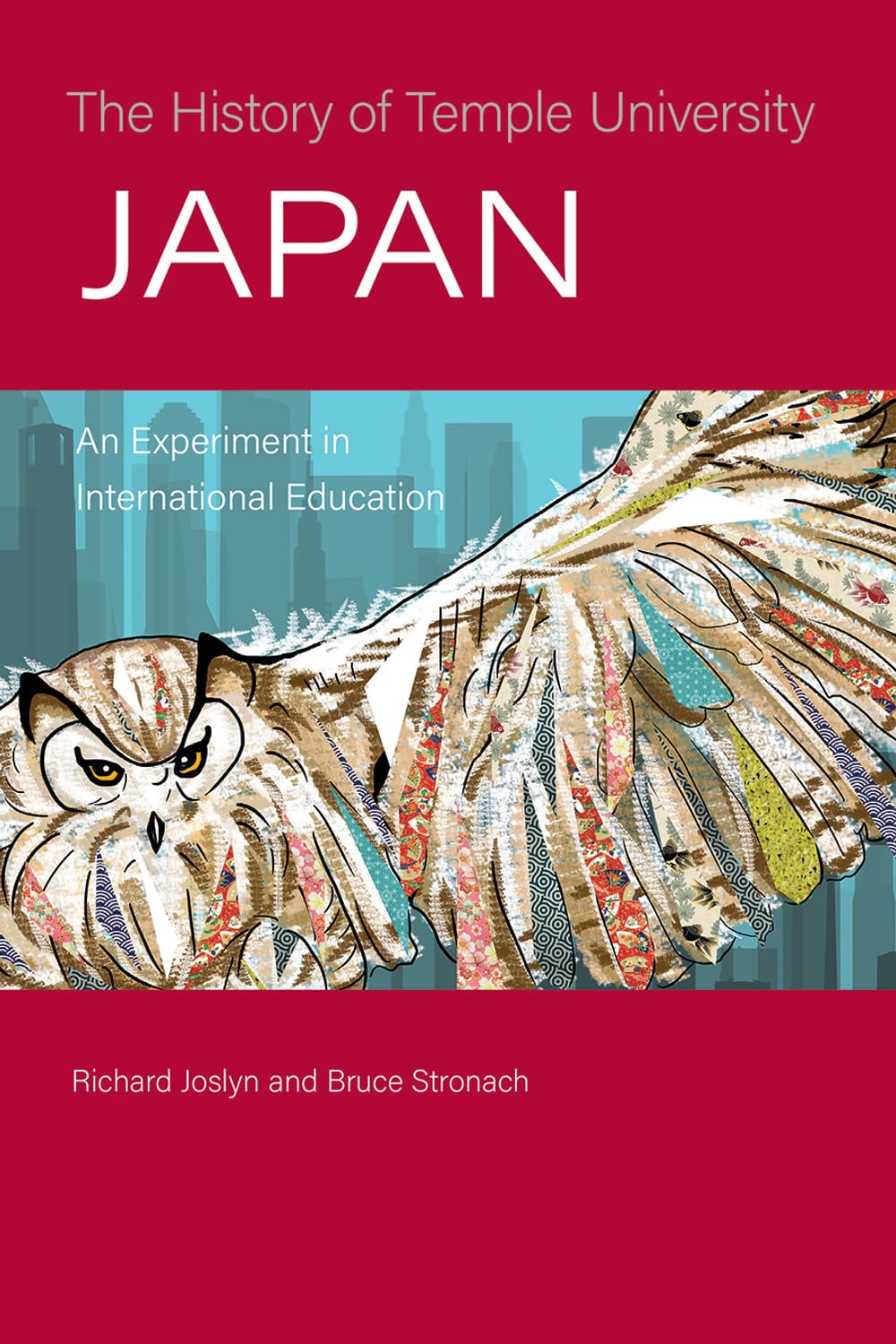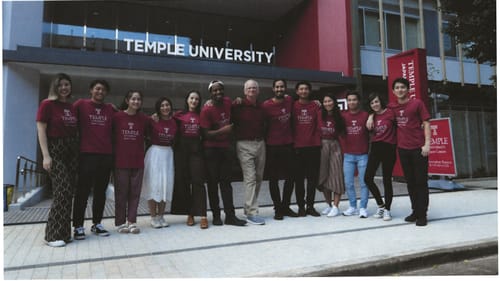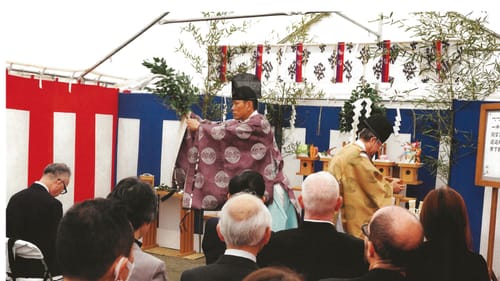Stay in the Loop
BSR publishes on a weekly schedule, with an email newsletter every Wednesday and Thursday morning. There’s no paywall, and subscribing is always free.
An American first in Japan
The History of Temple University Japan: An Experiment in International Education, by Richard Joslyn and Bruce Stronach

If attending the Subaru Cherry Blossom Festival of Greater Philadelphia this April (an annual celebration of blooming trees and Japanese arts and culture) makes you want to learn more about Philly’s ties to Japan, it’s the perfect time to pick up a new book: The History of Temple University Japan: An Experiment in International Education. Don’t be deceived by the pedestrian title; this is a compelling and suspenseful story of diplomatic intrigue, political ambition, last-ditch rescues, frenemies, heroes, and, for good measure, a nuclear meltdown. Who knew higher education was like this?
In 1982, amid a terrible economy, it seemed to defy logic that a Philadelphia-centric commuter university would expand at all—but to Japan? That’s just what Temple did, and former deans Richard Joslyn and Bruce Stronach tell the complex story.
American academics in Japan
Today, Temple University Japan (TUJ) is thriving. It attracts students from around the world and has conferred more than 7,000 graduate and undergraduate degrees. Notably, it was the first American university to offer a full academic program in Japan and the first to achieve Foreign University, Japan Campus status, a classification that benefits its students and enables international recruitment.
The authors credit a legion of Temple insiders and outsiders with navigating the many obstacles TUJ faced, as well as Japan’s strong desire to internationalize.
Marvin Wachman nurtured international study throughout his Temple presidency (1973-1982) and believed Asia was an important frontier. He was receptive when Japanese businessman Hirayasu Yamamoto suggested Temple take its well-regarded intensive English language program to Tokyo. The thinking was that language study would be a bridge for Japanese students into Temple degree programs. The plan came together quickly, and classes began just weeks before Wachman’s June 1982 retirement.

Wachman’s successor, Peter Liacouras, arrived in office to mounting fiscal challenges across the university. He had not previously been involved with TUJ and conceivably could have abandoned the experiment when it was discovered that Temple’s Japan facilitator Yamamoto had appropriated $300,000 of tuition payments for his own expenses. Wachman had already revoked all agreements with Yamamoto and given on-the-ground authority to Temple faculty member William Sharp.
Close calls and key allies
TUJ was financially independent of Temple, relying on tuition and the financial backing of a Japan-based board of governors. It was also designed to operate as close as possible to not-for-profit. Instead of ending the program, Liacouras trusted positive assessments by Sharp and others and expressed enthusiasm to the TUJ board. “He was a visionary, determined to transform Temple from a commuter school into a national and international residential university, and … was now persuaded that TUJ could contribute to this transformation,” Stronach and Joslyn write. Few knew TUJ had almost ended before it began.
Charles Fishman, a colleague of Temple law professor Robert Reinstein, had a legal practice in Japan and good connections. He helped identify a new partner, ministerial official Chikara Higashi. Over the years, Fishman mediated several delicate situations that might have doomed the project.
Joslyn and Stronach spend a lot of time explaining financial crises: how they arose and were skirted, or confronted and resolved. The causes were many, including Japan’s prolonged 1990s recession, which withered enrollments and diminished TUJ’s reputation when many other American programs closed. TUJ differed in important ways: unlike the failed programs, it had not received Japanese government funding and it was still standing.
However, by mid-1995 the situation was dire, and a press release was prepared announcing the program’s termination. But several administrators, including Joslyn, who was involved with TUJ for 15 years, remained calm, kept all sides talking, and made enough progress to keep going. During Joslyn’s TUJ deanship (1996-2001), he presided over the board’s reconstitution along with efforts to make TUJ a Temple-owned and -managed institution, providing a stronger financial position from which to pursue official status in Japan, which would benefit students and permit sponsorship of foreign student visas, enhancing recruitment.
An educational survivor
The Chronicle of Higher Education in 2000 recognized Temple as a survivor among American campuses in Japan, saying students were “well served by an alternative form of education that emphasized rigor and classroom discussion, the linguistic and cultural diversity of its student body, the benefits of being located in Tokyo, the employment of its graduates, and ‘the backing of its home university.’”
Stronach is the longest-tenured (2008-2020) of nine deans and the second to come from outside Temple. In 2014, he allied with Mariko Bando, then-president of Tokyo’s Showa Women’s University (SWU), to devise TUJ’s relocation (its sixth) to SWU’s campus. The authors observe that finally having an academic partner was “of fundamental importance … TUJ and SWU believed that international diversity and a global perspective are necessary elements of higher education … The SWU project further solidified TUJ’s mission.”

With a stable location in a brand-new building, TUJ was ready to exploit its long-sought status as a Foreign University, Japan Campus, which Japan had granted in 2005. That accomplishment was the work of Stronach’s predecessor, Kirk Patterson, who had international and communications expertise, and the authors also credit the eventual involvement of the US government and embassy.
Embracing the culture
Teaching in Japan was popular and returning faculty were excellent ambassadors for TUJ. Yet adaptations were needed, as instructor Eleanor Wilnor commented: “I dealt with [Japanese students’] reluctance to speak up in class by asking for written questions … I was soon having a written conversation with each student … Silence was something I had to learn to live with … When a student would come to see me, there would be a period of silence, which I learned to honor …”
Language instruction and liberal arts coursework expanded to degree programs in business, law, education, linguistics, music therapy, and more, accompanied by non-degree programs.
Don’t judge this book by its title. More than the number of years or degrees offered or close calls survived, the history of TUJ is people. Leaders with an unlikely idea and the grit to pursue it, administrators in sticky situations pressing on, allies coming forward just in time, students and professors experiencing the unfamiliar, and the world getting a little smaller. In the end, Temple in Japan is evidence of perseverantia vincit, the phrase that encircles the university seal: perseverance conquers.
What, When, Where
The History of Temple University Japan: An Experiment in International Education. By Richard Joslyn and Bruce Stronach. Philadelphia: Temple University Press, 2023. 292 pages, paperback; $30. Get it here.
Sign up for our newsletter
All of the week's new articles, all in one place. Sign up for the free weekly BSR newsletters, and don't miss a conversation.
